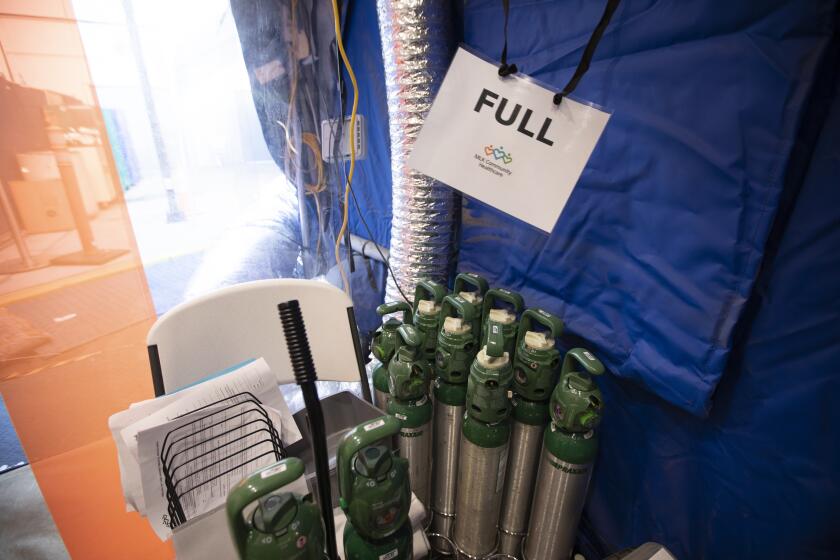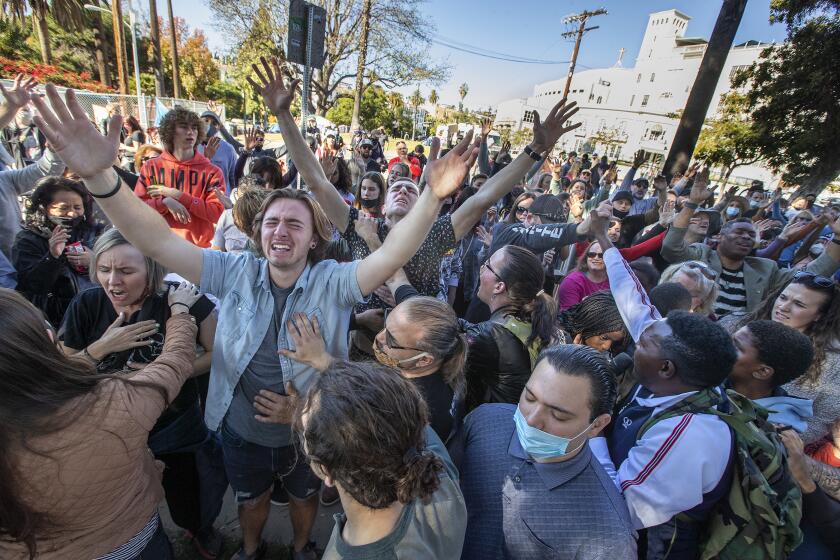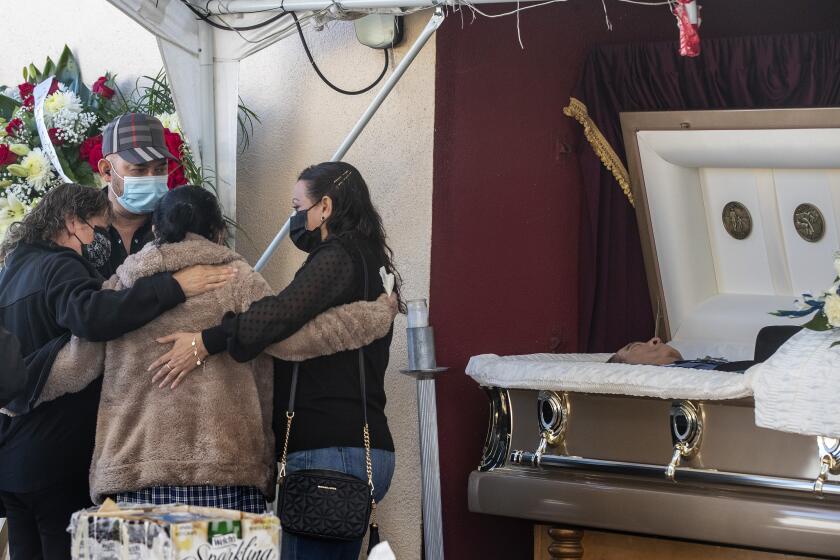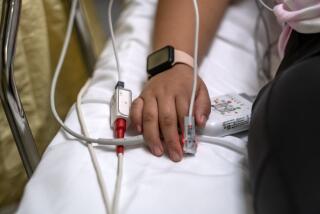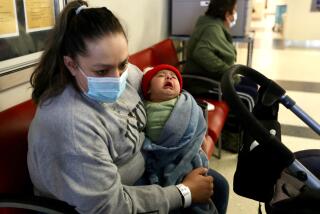Medical care suffers across L.A. County — even basic services outside COVID-19 wards
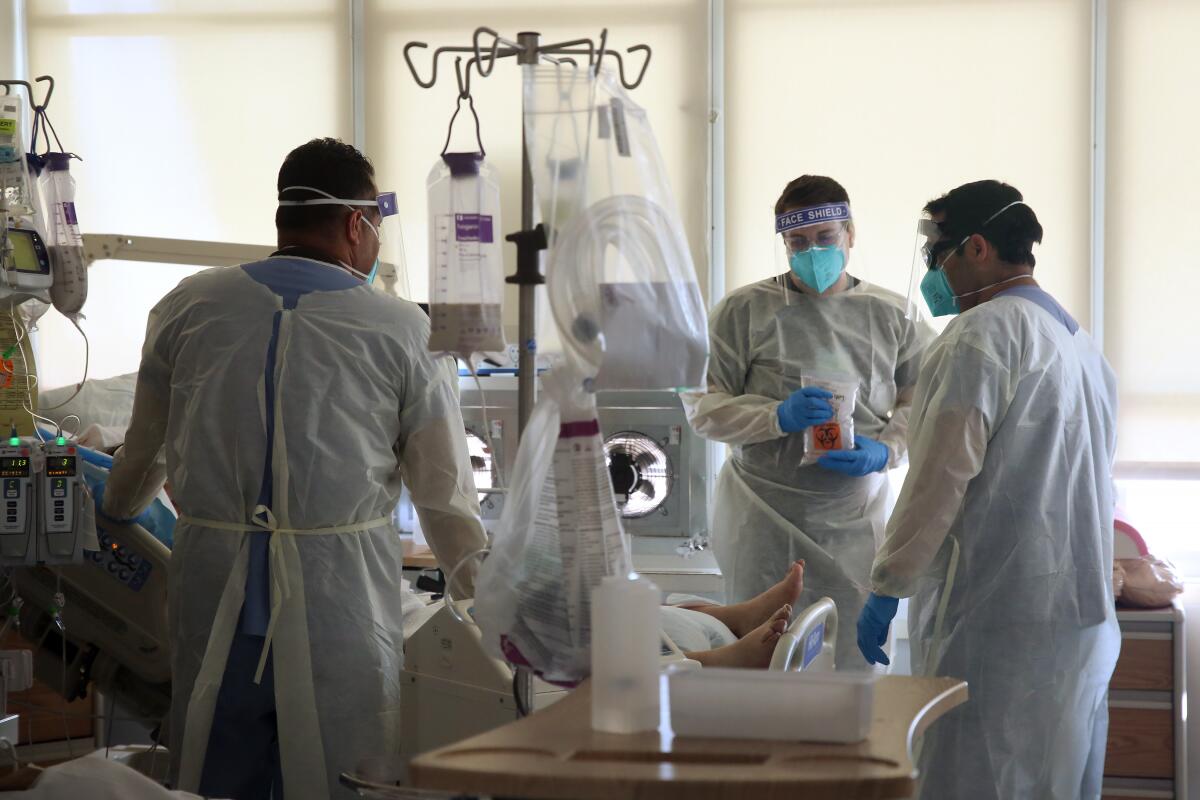
Coronavirus patients are overwhelming many Los Angeles County emergency rooms and intensive care units, and hospitals are seeing ripple effects that harm operations and care across the medical network.
With 700 nurses from primary care clinics diverted to hospitals and other critical needs, county officials have been forced to temporarily shut five public primary care clinics across the county and reduce hours at most of the others, which provide children with immunizations and where people with chronic diseases have their medications managed.
“We have kept a skeleton crew to continue to work in our outpatient clinics,” said Dr. Christina Ghaly, the L.A. County director of health services. “But overall, our capacity for outpatient services is much less than it is in routine times.”
This means that patients with chronic illnesses will be at greater risk of needing to go to the emergency room if they become more seriously ill because of the lack of outpatient care.
“But in the absence of sufficient staff to care for our inpatients, we don’t have a better option,” Ghaly said.
Paramedics are now regularly deciding not to transport noncritical patients to overcrowded hospitals, hoping to free up space for those most in need. This has forced people who might otherwise go to the emergency room to look elsewhere for care.
Hospitals are scrambling to find staff. Sometimes emergency medical technicians are asked to work in hospitals. Older hospitals are being reconfigured to house far more patients than they ever anticipated holding.
Patients, suffocating from their inflamed lungs, are in need of oxygen to the extent that some hospitals are starting to lack the adequate air pressure needed to sustain a high flow rate for oxygen delivery. “Running low of oxygen and oxygen tanks is an issue,” said Cathy Chidester, director of the L.A. County Emergency Medical Services Agency.
A chronic shortage of oxygen tanks is a problem for hospitals trying to discharge recovering COVID-19 patients as fast as possible, as they often need to be sent home with oxygen tanks.
“There’s only so much oxygen equipment and vendors that do these supplies of home oxygen therapy,” Chidester said. It has also been difficult to transfer patients from smaller hospitals who need more specialized care from larger hospitals who can better care for patients suffering from things such as trauma, heart attacks and strokes, she said.
Sometimes, there are no beds available in hospitals better equipped to handle those types of patients.
“We’re experiencing extreme conditions in L.A. County,” said L.A. County Public Health Director Barbara Ferrer. “Our hospitals continue to be overwhelmed. As more and more people are rushed to hospitals, the tragic fact is that hundreds more people will die every week from COVID-19. These trends, unfortunately, will continue into January.”
On Friday, California hit two more milestones, surpassing 2.3 million cumulative coronavirus cases and more than 26,000 cumulative COVID-19 deaths.
But there was one small bit of hopeful news released on New Year’s Day. For the first time in 50 days, the net number of people hospitalized in L.A. County for COVID-19 decreased — although only by one.
On New Year’s Eve, there were 7,627 COVID-19 patients hospitalized in L.A. County, down from 7,628 the day before, according to data released Friday. New Year’s Eve snapped a 32-day consecutive daily streak of record-breaking COVID-19 hospitalizations in L.A. County.
Over the last seven days, L.A. County has added a net additional 122 new COVID-19 patients to its hospitals, a slower pace than that between Dec. 16 and Dec. 22, when an average of 234 net new COVID-19 patients were hospitalized daily.
The slower increase in daily patients is a sign that the stay-at-home order in place in Southern California for nearly four weeks is having an impact.
“There’s no question in my mind that had we not had the stay-at-home order, the situation would be far more dire than it is now,” said Dr. Robert Kim-Farley, medical epidemiologist and infectious diseases expert at the UCLA Fielding School of Public Health.
“However, I think the magnitude of the numbers show that in the face of the stay-at-home order, many people are choosing to ignore it, and with no strong enforcement, these mixing of households and parties continue to occur,” Kim-Farley said.
Any slight easing in new COVID-19 hospitalizations will probably be reversed soon because of the amount of travel observed over Christmas and New Year’s, said Kim-Farley said, adding that he expected the number to start to rise.
Kim-Farley said L.A. County is in the midst of a “viral tsunami,” but “we should not be frozen in despair that there is nothing we can do.”
ICUs so far are still being hit hard. There’s been a net additional 38 critically ill patients entering L.A. County ICUs daily over the last week, only slightly better than Dec. 12-18, when a net average of 44 critically ill patients were added daily.
Hollywood studios have started to respond to L.A. County health officials’ plea to consider suspending film productions because of the catastrophic spike in disease.
ABC Signature and 20th Television will delay the resumption of production in L.A. of 16 programs by at least a week later from its earlier plans, according to a source close to production who declined to be named.
Some hospitals don’t have the infrastructure to supply all the oxygen needed by COVID-19 patients gasping for breath. Federal engineers are coming to assist.
Those productions include “911,” “911: Lone Star,” “American Crime Story: Impeachment,” “American Horror Story,” “American Housewife,” “Big Shot,” “black-ish,” “Grey’s Anatomy,” “Last Man Standing,” “Love, Victor,” “Mayans,” “Mixed-ish,” “The Orville,” “Rebel,” “Station 19,” and “This is Us,” the source said. A Disney spokesman declined to comment. Productions will resume on Jan. 18 at the earliest.
Universal Television is extending its holiday hiatus on six shows by at least a week.
Production on five shows — NBC’s “Mr. Mayor,” “Kenan” and “Good Girls,” HBO Max’s “Hacks” and Netflix’s “Never Have I Ever” — will resume Jan. 11, instead of Jan. 4, according to a person close to production, who declined to be named. Production on NBC’s “Brooklyn Nine-Nine” will resume Jan. 18, said the source, who was not authorized to comment.
CBS Studios has delayed resuming production by a week, to Jan. 11, on some of its shows.
Sony Pictures Television has delayed resuming production on ABC’s “The Goldbergs” and Netflix’s “Atypical” by a week to the week of Jan. 11, to accommodate additional testing, according to a person close to production who declined to be named. “Jeopardy!” and “Wheel of Fortune” will resume work on Jan. 11 as originally planned, the person said.
There have been clusters of coronavirus infections identified among workers at three Warner Bros. productions in Burbank — on the set of “Lucifer,” “The Kominsky Method” and “Young Sheldon.” In total, 35 people are have tested positive as part of those clusters of infections, according to data released by the L.A. County Department of Public Health.
Sean Feucht again defied health warnings. Kirk Cameron also drew a crowd to Pt. Mugu Beach in Ventura County but it was smaller
An additional 45 positive coronavirus cases have been identified at the CBS Studio Center in Studio City, according to the county data. Twenty-three coronavirus cases have been identified among workers at NBC Universal in Studio City and Universal City, as have nine coronavirus cases among staff at Netflix Productions office in Gardena.
As more deaths occur in L.A. County, there are some troubling trends. A greater percentage of people in L.A. County are dying of COVID-19 without having any underlying health conditions, Ferrer said. Earlier in the pandemic, more than 90% of those who died had underlying health conditions; now, 86% of those who died had underlying health conditions.
“There are more people than ever not only passing away, but passing away without any underlying health conditions,” Ferrer said.
The threat to relatively young adults was hammered home nationwide this week when Luke Letlow, who had been elected to become Louisiana’s newest Republican member of the U.S. House, died Tuesday night from complications related to COVID-19, only days before being sworn into office. Letlow was 41 and reportedly had no underlying health conditions.
In Los Angeles County, the ripple effect is being seen at many medical facilities.
The crush of patients has led the county to allow certain types of ambulance patients to be offloaded into the waiting room instead of the emergency room, according to memos issued by the EMS agency.
Additionally, 911 patients who have a do-not-resuscitate directive will not be taken to acute-care facilities such as a hospital, nor will certain trauma patients whose hearts have stopped.
The agency is also allowing emergency medical service providers to decline to take low-risk patients to hospitals with mild respiratory illnesses.
Many hospital morgues are now filled with bodies, and officials are trying to move them into temporary storage at the county medical examiner-coroner’s office. Mortuaries have also run out of space and are turning away grieving families. Single-day COVID-19 death records were broken every day for the last three days of the year, with 242 deaths reported Tuesday, 262 on Wednesday and 291 on New Year’s Eve.
Spiraling COVID-19 deaths leave morgues overflowing and funeral homes turning away grieving families
A months-long surge of coronavirus cases in Los Angeles County is reaching its grim if inevitable zenith
Alarmingly, the daily rate at which coronavirus test results are coming back positive has climbed to 22%, more than five times the rate from Nov. 1, when it was less than 4%.
“This high positivity rate remains alarming and tells everyone that the coronavirus is very prevalent and persistent across all corners of the county,” Ferrer said.
On Thursday, county officials said lengthy delays in offloading patients at Los Angeles County’s critically overcrowded hospitals are increasingly keeping ambulances from being able to respond to other emergency calls.
Sometimes as many as 10 ambulances are queued up waiting to drop off patients, and “we’ve had patients waiting in ambulance bays outside of [emergency departments] for seven hours, eight hours,” the EMS agency’s Chidester said.
At Providence Holy Cross Medical Center in Mission Hills, patients are being treated in places that usually don’t house beds, such as the gastrointestinal lab, the outpatient area for same-day surgeries and even at the end of hallways, on gurneys surrounded by privacy curtains.
“It’s pretty bad,” said Jodi Hein, the hospital’s chief nursing officer. “We have two additional morgue trailers we’ve not had to use before that we are using now.”
The hospital was short 12 registered nurses on Wednesday because of the overflow of patients. The nurses who usually care for patients coming into and out of surgeries and elective procedures — all of which have been canceled — have dispersed to other units, Hein said.
Because of a shortage of phlebotomists, nurses have also been helping draw blood throughout the hospital. The ICU itself has been short several nurses for weeks, Hein said. But in addition to COVID patients, the department is beset with typical traumas. Within a 10-minute span on Tuesday, two trauma patients arrived needing blood transfusions. Another was admitted for a stroke, yet another for a heart attack.
“We get encumbered really easily in the emergency department, especially right now,” Hein said.
Physicians have been releasing patients earlier than they usually would to make room for new patients, Hein said. A patient in normal times might stay in the hospital for an additional eight hours for more tests and consultations, but doctors are scheduling those for later dates if they aren’t urgent.
Because visitors are not permitted in the hospital, doctors have even helped patients connect with their families through iPads over the holidays — usually the job of chaplains, who have been busier than ever.
“Everyone is just exhausted,” Hein said. “But we’re making it, we’re doing it, and I think the staff is just really trying to be as positive as possible.”
Times staff writers Andrew J. Campa and Wendy Lee contributed to this report.
More to Read
Sign up for Essential California
The most important California stories and recommendations in your inbox every morning.
You may occasionally receive promotional content from the Los Angeles Times.
